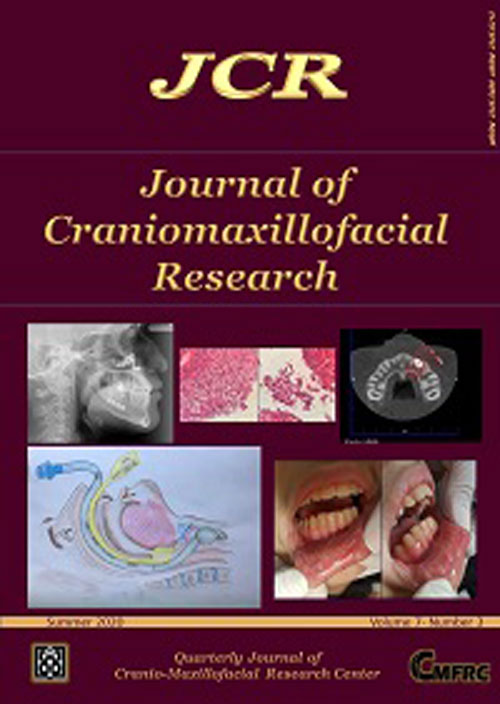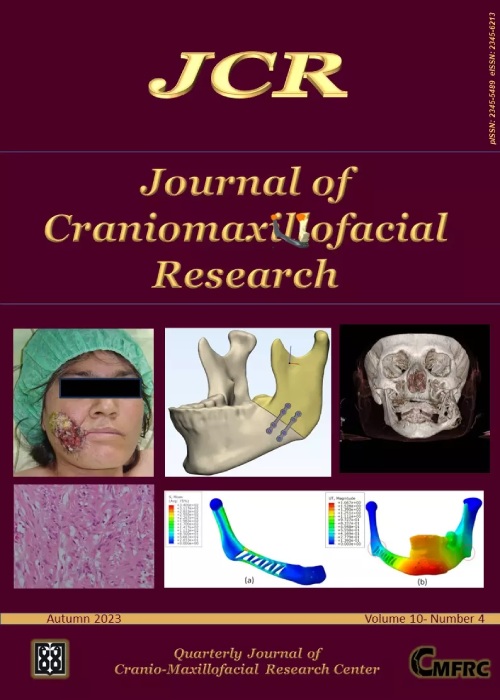فهرست مطالب

Journal of Craniomaxillofacial Research
Volume:7 Issue: 3, Summer 2020
- تاریخ انتشار: 1399/10/06
- تعداد عناوین: 8
-
-
Pages 110-125Aims
Temporomandibular disorders (TMD) are one of the most prevalent disorders in maxillofacial area. Due to lack of understanding of the etiology or pathogenesis of TMD and a definitive diagnostic or therapeutic approach, patients have to tolerate symptoms such as pain. This study was aimed to perform a review of non-surgical treatment methods for TMD.
Materials and MethodsIn this review, Google, Google Scholar, PubMed, SID, ISI Web of Science, SID and IranMedex databases were searched using key terms: temporomandibular disorders, temporomandibular joint, temporomandibular pain, non-surgical treatment. Articles meeting the inclusion criteria were recruited in the study. Finally, a total of 63 prospective linical trials were evaluated from 2015 to 2020.
ResultsFrom the 61 studies evaluated, 27 studies were on low-level laser therapy (LLLT), 13 studies on transcutaneous electrical nerve stimulation (TENS), 5 studies on acupuncture and dry needling, 1 study on laser acupuncture, 9 studies on platelet-rich plasma (PRP) and 6 studies on Botox injection.
ConclusionLaser acupuncture had similar treatment effects in reducing pain to TENS, low-level laser, acupuncture and dry needling. It seems that the use of laser acupuncture is safer than other methods in decreasing pain of patients with TMD.
Keywords: Temporomandibular disorders, Low-level laser, Acupuncture, Transcutaneous electrical nerve stimulation, Botox -
Pages 126-131Introduction
Tooth enamel is a precious and highly mineralized tissue in the human body. Amelogenesis Imperfecta (AI) is a developmental, evolutionary and hereditary disease presents with the rare abnormal formation of enamel that affects the primary and secondary dentition. The molecular base of the incomplete quinizium together with clinical manifestation suggest that AI may result from mutations in the FAM83H and ENAM genes. In this study, we aimed to evaluate the association between Amelogenesis Imperfecta and mutations in the FAM83H and ENAM genes in 18 Iranian families with AI in dominant and non-syndromic form.
Materials and Methods18 Iranian families with at least 1 patient with Amelogenesis Imperfecta were included in this case study and were examined for related specific manifestations and also, 10CC of blood was taken from each patient followed by PCR and genome sequence for genetic alterations in FAM83H and ENAM. Genome sequences were analyzed using CLC software and CLC Sequence Viewer was used to compare them with reference sequences in the RefSeq database at the NCBI later were discussed together with clinical manifestations for each patient.
ResultsAll patients showed a mutation in the exon 5 of FAM83H gene in nucleotide rs56148058C/T which converted Serotonin to Aspartin. In two patients carried a mutation in the nucleotide rs546809055A/G that changed Leucine to Phenylalanine. None of patients showed significant alteration in the ENAM gene.
ConclusionThis study indicates that FAM83H gene plays an import role in incidence of Amelogenesis Imperfecta in Iran.
Keywords: Amelogenesis imperfecta, Gene mutation, FAM83H, ENAM -
Pages 132-137Introduction
Oral Squamous Cell Carcinoma (OSCC) is one of the most common oral malignancies, which accounts for 80-90% of malignant neoplasms of the oral cavity. MicroRNAs (miRNAs) are small RNA molecules that regulate post-transcriptional gene expression by targeting mRNAs.
Materials and MethodsIn this case-control study, 40 patients with oral squamous cell carcinoma and 40 healthy individuals as control were studied. Blood samples were collected from both groups. Also, 30 cancer tissue samples and 30 healthy tissue samples were prepared and evaluated. RNA was extracted from collected peripheral blood and tissue samples and evaluated for the expression level of miR-494 via real-time PCR technique. P. value values<0.05 were considered statistically significant.
ResultsThe expression level of miR-494 in serum (peripheral blood) of patients with oral squamous cell carcinoma increased by 1.12 fold (P-value<0.001) compared with healthy individuals. Also, the expression level of miR-494 in samples of oral squamous cell carcinoma infected tissue showed a 1.28-fold increase compared to healthy tissue.
ConclusionThe results of this study indicate an increase in the expression level (up-regulation) of miR-494 in oral squamous cell carcinoma. This biomarker can be used in screening and early detection of oral squamous cell carcinoma.
Keywords: Oral squamous cell carcinoma, Microrna, Real-time pcr, MiR-494 -
Pages 138-144
Background & Objective:
Impacted teeth are one of the most common reasons for visiting dentists and maxillofacial surgeons. During clinical and radiographic examinations and evaluations, the dentist sometimes realizes that the patient’s problem is due to the impaction of one or more teeth. Therefore, it is necessary for every dentist to make the necessary and correct decision for the treatment of such teeth. One of the best ways to diagnose impacted teeth is first of all the absence of that tooth in the desired location and clinical evaluation of the patient and secondly to check the radiographic view of the desired area. Impacted teeth can be the source of many problems for various reasons, so in most cases, their extraction is recommended. Knowing how to place the impacted tooth and determining its type and other characteristics of the impaction can help the dentist in choosing the appropriate treatment-surgical method and also prevent complications during surgery. Proper and timely diagnosis of impaction as well as determining its position (buccal- palatal-intermediate) in the jawbone can reduce damage to adjacent structures and also affect the treatment plan. Because accurate detection of impacted tooth positions is possible with radiography, the most accurate radiograph to examine the impacted tooth is cbct images. Therefore, due to possible occlusion injuries and the effect of occlusion pattern on the treatment of these teeth, it is important to study the types of impaction patterns. Therefore, this study was presented with the aim of investigating the impaction pattern of maxillary canine teeth in Ardabil with cbct archive.
Materials and MethodsIn this descriptive cross-sectional study, CBCT images of 239 patients who met the inclusion criteria were evaluated. Due to the lack of statistics, due to the lack of statistics of maxillary impacted canine teeth in Ardabil, the counting method was used for sampling and stereotypes were identified as maxillary impacted canine teeth as the sample size. The obtained data were analyzed in SPSS24 software.
ResultsAmong the impacted canine teeth studied, 63.2% had palatal, 17.5% buccal and 19.3% had intermediate pattern. Also, 11.2% had damage to adjacent structures and 88.8% had no damage to adjacent structures. Among the types of damage to adjacent structures, 46.9% caused root resorption of the first premolars, 34.5% caused root canal resorption, and 18.6% had other damage to adjacent structures. Of these, 50.4% had root curvature and 49.6% had no root curvature, of which 12.1% had severe curvature, 38.7% had mild curvature and 49.2% had severe curvature. Also, the average angle of the incised canine to the lateral incisor was 41.7%. 9% of impacted canine teeth had a root resorption of lateral incisors and 9% did not have a root resorption of lateral incisors.
ConclusionDentists should treat cases such as maxillary latent canine such as: Examine the occlusion pattern, angle to adjacent teeth, damage to adjacent structures, curvature of the incised canine root, and root resorption of adjacent teeth.
Keywords: Maxillary canine, Impacted teeth, CBCT -
Pages 145-151Introduction
The aim of this study was to compare the efficiency of soft and hard splints in treating patients with clenching.
Materials and MethodsIn this clinical study, 26 patients with clenching disorder randomly divided to two equal group of treatment: hard and soft splint. The amount of masticatory muscle pain and maximum mouth opening were measured at the delivery time and 3, 6, 9, and 12 weeks later by a blind examiner. Data were analyzed by independent T and repeated measure ANOVA tests with significance level of p=0.05.
ResultsHard and soft splints were resulted in significant reduction of masticatory muscle pain (hard: P<0.001, Soft: p<0.001) and increase in maximum opening (hard P<0.001, Soft p<0.003), but there was no significant difference between them in pain relieving (P=0.848) and maximum opening (P=0.622).
ConclusionThis study showed that efficacy of hard and soft splints in treating patients with clenching is same.
Keywords: Masticatory muscle, Maximum mouth opening, Occlusal splint, Pain -
Pages 152-153
Parapharyngeal packing during Maxillofacial surgery prevents passing blood and liquids into stomach. The use of cotton pack has some disadvantages like missing and retained pack at the end of surgery. Foley catheter is a good substitute for that.
Keywords: Maxillofacial surgery, Parapharyngeal packing, Foley catheter -
Pages 154-157
This article reports a 13-year-old boy with phenylketonuria and multiple superficial mucoceles on his lower lip. Phenylketonuria (PKU) is a serious and rare genetic disorder that affects the levels of amino acids such as phenylalanine in the body. If left untreated, PKU can negatively affect mental function and cause retardation. Patients with PKU receive less oral examination compared to the normal population. Mucoceles are lesions formed by the accumulation of mucous of salivary glands in soft tissue by blockage or extravasation. Local trauma has been identified as the main cause of mucoceles development. Superficial mucoceles are rare in the lower lip. These patients need close oral and maxillofacial examination to find problems, which may be related to their systemic problem. Micro-marsupialization is a conservative therapeutic approach for management of pediatric oral mucoceles. Management of trauma in patients with mental retardation is an important issue.
Keywords: Mucocele, Phenylketonuria, Genetic disorder, lower lip, Salivary gland -
Pages 158-164
The purpose of Dentofacial Deformity Treatment is to achieve the proper aesthetic and functional occlusion results. Conventional orthognathic surgery involves a long-term orthodontic phase before surgery for about 18 months, in which patients’ facial appearance worsens and their motivation decreases. In the SFA (surgery first approach) method, the surgery is performed before orthodontics and orthodontic therapy is performed to improve dental occlusion and final settlement. Two main advantages of this method are the reduction of the therapy period and the initial improvement in the patient’s facial appearance. The SFA has certain benefits, especially in Class 3 malocclusion. In this case report, a 19-year-old girl with a relatively severe Class 3 malocclusion with skeletal discrepancy due to a mandibular prognathism and maxillary retrognathism, and asymmetrical face with chin deviation to left is presented with a unilateral posterior cross bite which was effectively treated using the SFA protocol. The SFA therapy was performed by removing orthodontics before surgery, followed by maxillary advancement surgery, and posterior maxillary impaction and postoperative orthodontic sets to dental alignment and settling the occlusion. Despite the overall reduction in the orthodontic therapy period to less than 9 months, good results and functional occlusion were obtained.
Keywords: Surgery first, Orthognathic surgery, Skeletal class III, Malocclusion, Orthodontictreatment


